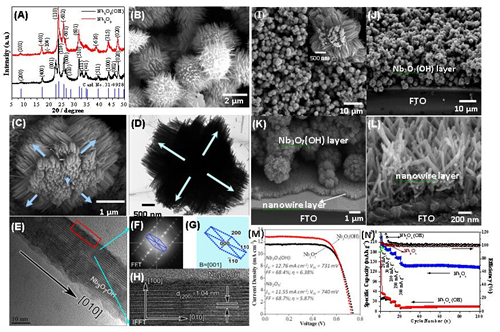Niobium-based oxides possess varieties of composition and structure, such as NbO, Nb2O3, Nb2O5 and Nb3O7X (X=OH, F) with different nanostructure forms of nanoparticles, nanorods and nanobelts. Owing to their unique composite and structural properties, these niobium-based oxides draw intensive attention in energy storage and conversion fields. However, their relatively low surface area generally results in low performance of materials when applied to energy technology.
To tackle the issues mentioned above, a research group in Centre of Environmental and Energy Nanomaterials (CEEN), Institute of Solid State Physics, Hefei Institutes of Physical Science, made progress in controllable synthesis and applications of highly ordered Nb3O7 (OH) nanowire array assembled three-dimensional (3D) structures in dye-sensitized solar cells (DSSCs) and lithium-ion batteries (LiBs). The related work was published in ACS Nano entitled Highly Ordered Single Crystalline Nanowire Array Assembled Three-Dimensional Nb3O7 (OH) and Nb2O5 Superstructures for Energy Storage and Conversion Applications.
The research group fabricated highly ordered single crystal Nb3O7 (OH) nanowire array assembled 3D structure material by a facile hydrothermal method (figure A-L). The obtained 3D Nb3O7 (OH) nanowire array structure possesses high surface area of 121.5 m2g-1 and microporous/mesoporous structure, which can be directly hydrothermally grown onto FTO conducting glass substrate to form stable 3D Nb3O7(OH) nanowire array structure film. With no need for further high-temperature thermal treatment, the fabricated 3D Nb3O7 (OH) nanowire array structure film onto FTO can be directly used as photoanode for dye-sensitized solar cells, exhibiting superior light-to-electricity conversion efficiency (figure M).
Additionally, this obtained 3D Nb3O7 (OH) nanowire array structures after high-temperature thermal treatment can readily transform into Nb2O5 nanowire array structure with well-preserved 3D framework structure and a surface area of 81.8 m2g-1. As anode material, the obtained 3D Nb2O5 nanowire array structure is potentially applicable to lithium-ion batteries (LiBs) (figure N). The superior performance in DSSCs and LiBs can be ascribed to the 3D Nb3O7 (OH) and Nb2O5 materials with high surface area, porous structure and high crystallinity of nanowires, which help to improve dye molecule adsorption, mass transport and electron transfer.
This study was sponsored by the Strategic Priority Research Program of the Chinese Academy of Sciences.

(A-L) XRD patterns, SEM and TEM images of 3D Nb3O7(OH) nanowire array structure; (M) DSSCs performance; (N) LiBs performance. (Image by ZHANG Haimin)
Contact:
ZHANG Haimin
Key Laboratory of Materials Physics, Centre for Environmental and Energy Nanomaterials,Institute of Solid State Physics, Hefei Institutes of Physical Science
Hefei 230031, Anhui, China.
Tel: +86 (0)551 65591973
E-mail: zhanghm@issp.ac.cn
 Tel: +86-551-65591206
Tel: +86-551-65591206
 Fax: +86-551-65591270
Fax: +86-551-65591270
 Emai: zhous@hfcas.ac.cn
Emai: zhous@hfcas.ac.cn
 350 Shushanhu Road
350 Shushanhu Road